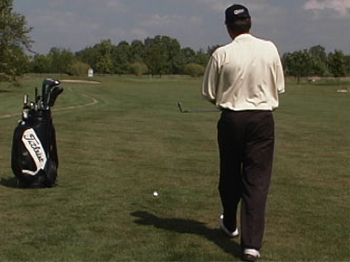A stable preshot routine is your template for consistency in a round of golf. By repeating the same procedure prior to each shot, you will gain confidence and reliability in your game regardless of the pressures during the round. In addition, you will develop a rock solid set-up everytime to the ball.
Most of all the control you exude during a golf shot comes from these four pre-swing elements - the grip, alignment, ball-position, and posture. In a good pre-shot routine, a player will subconsciously cover all these pre-swing elements with precision and accuracy. It is also important to note that a pre-shot routine should not be so exact each time that it consumes the player. It must be natural not mechanical. Generally, a good routine is loose enough to cover all the pre-swing elements and it lasts between 15 and 25 seconds.
Steps to Developing a Routine
1.
All good players begin their routines by standing behind the ball-target-line. From this perspective it is easy to see the line you want the ball to start on. It is good to pick out an exact point in the distance where you want the ball to go. Keep in mind this point is not always the flag. Also be specific, a point like the fairway is too general and errand shots could result. A tree limb, bush or anything that stands out is the best point. Now, pick out another spot along the same line as your distance target point just a few feet from the ball. When we walk up to the golf ball later, it will easier to aim the clubface to this spot instead of the spot in the distance.This spot is called our intermeidate target.
2.
 Next, assume your grip. Start by placing your target hand on the club then lift the club up off the ground and place your trail hand on. Do this as you occasionally look at the target. Begin walking into the golf ball from the right side travel. You should waggle the club a few times to get some feel for the shot. This gives you a sense of motion and keeps things more relaxed. Note: when you do your grip be especially aware of the leading edge relation to your target hand.
Next, assume your grip. Start by placing your target hand on the club then lift the club up off the ground and place your trail hand on. Do this as you occasionally look at the target. Begin walking into the golf ball from the right side travel. You should waggle the club a few times to get some feel for the shot. This gives you a sense of motion and keeps things more relaxed. Note: when you do your grip be especially aware of the leading edge relation to your target hand.
3.
 As you walk into the golf ball set the club face directly behind the ball keeping the leading edge aimed precisely at the intermediate target you picked out earlier. This is a critical step. After you line the clubface up, you are also marking an imaginary line so we can square our body up to later.
As you walk into the golf ball set the club face directly behind the ball keeping the leading edge aimed precisely at the intermediate target you picked out earlier. This is a critical step. After you line the clubface up, you are also marking an imaginary line so we can square our body up to later.
4.
 Next, place your feet together in front of the ball and perpendicular to the ball-target-line. Assume your stance by stepping forward with your target foot and parallel the target-line. Widen you back foot parallel to the ball-target-line. The width of your back foot is determined by the length of the club. Make sure your hips, knees, forearms, and eyes are all parallel the target-line at this time.
Next, place your feet together in front of the ball and perpendicular to the ball-target-line. Assume your stance by stepping forward with your target foot and parallel the target-line. Widen you back foot parallel to the ball-target-line. The width of your back foot is determined by the length of the club. Make sure your hips, knees, forearms, and eyes are all parallel the target-line at this time.
5.
 Now, get into your posture. Take time to set some good angles. Remember to take several looks at the target during each phase of the routine.
Now, get into your posture. Take time to set some good angles. Remember to take several looks at the target during each phase of the routine.
Make a few practice swings or waggles before the shot. Commit to the shot totally before the swing. Make your swing a reaction to the target rather than a creation or mechanical movement.


